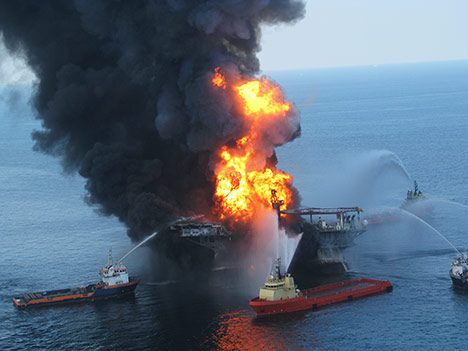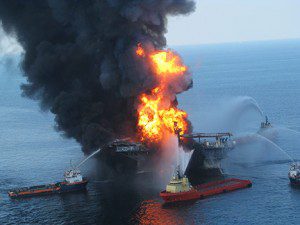
15 Jun EARTH MATTERS: BREAKING OUT OF THE DISASTER CYCLE
 Disasters do not just happen, and the physical environment is only one of many factors that causes or exacerbates disasters. Understanding the combination of ecological and sociocultural elements that create vulnerability to risk is key to reducing that vulnerability. Power relations, ideologies, and social constructions play a key role in understanding both “natural” and human-caused catastrophes. The media often ignore political, social, and economic factors involved in disasters, focusing instead on the physical causes of disasters. Similarly, after a disaster – as, for instance, in the case of oil spills and other human/natural disasters – the media tend to focus on environmental, rather than social, effects. As a result, blame is transferred to “Mother Nature” or “acts of God” instead of attached to social action or inaction, and government and industry are relieved of responsibility.
Disasters do not just happen, and the physical environment is only one of many factors that causes or exacerbates disasters. Understanding the combination of ecological and sociocultural elements that create vulnerability to risk is key to reducing that vulnerability. Power relations, ideologies, and social constructions play a key role in understanding both “natural” and human-caused catastrophes. The media often ignore political, social, and economic factors involved in disasters, focusing instead on the physical causes of disasters. Similarly, after a disaster – as, for instance, in the case of oil spills and other human/natural disasters – the media tend to focus on environmental, rather than social, effects. As a result, blame is transferred to “Mother Nature” or “acts of God” instead of attached to social action or inaction, and government and industry are relieved of responsibility.
As anthropologist (and Telluride local) Dr. Susanna Hoffman noted in her excellently edited book, “The Angry Earth: Disaster in Anthropological Perspective,” the disaster cycle all too often follows a trajectory, from intense public interest and concern to apathy and even annoyance. While an initial influx of funds and energy is certainly necessary for dealing with the immediate effects of disasters, long-term challenges, often structural/institutional, can remain unaddressed and often even unseen. No bright line defines passage into the closure phase. Victims return to a more normal life, relief and recovery efforts end and social interactions return to a less confrontational pattern. Closure does not necessarily imply resolution, change, and greater understanding.
Communities that are already vulnerable are more susceptible to risk; furthermore, disaster relief efforts can exacerbate and accentuate existing socio-economic inequalities. This vulnerability is often first caused by unequal standing and treatment of marginalized communities, and subsequently forms part of a vicious circle of ever-worsening conditions. Understanding disasters requires studying not only the natural hazards, but also the sociopolitical and economic factors that put people into the path of disasters. Both disaster relief and disaster preparedness efforts tend to look only at technical solutions, ignoring these underlying factors. This was certainly evident in the early aftermath of the BP Horizon oil disaster, with Kevin Costner touting a new oil vacuum and Louisiana Governor Bobby Jindal calling for immediate building of sand berms (which created a mini-disaster in itself when the ill-planned effort led to tractors sinking into the Gulf, adding to the pollution problem).
Disasters can therefore reinforce existing power structures. At the same time, they offer opportunities for change. Disasters stem from a combination of factors – risks combined with human patterns of activity. Risk does not always lead to disaster, but it can; after all, this is why society tries to avoid unnecessary risks. To address disasters, then, we need first to understand what the underlying institutional, organizational, social, and cultural causes of the risks are. Once we understand that, we can build resistance and resilience to their recurrence by addressing two factors. First, we can minimize the risk, which is defined by hazard times probability, by reducing either the hazard itself or the likelihood of its occurrence, or both. Second, we can adjust human patterns of activity that exacerbate the damage risk can cause. Both factors involve planning, adaptive management, and monitoring, and both rely on high levels of community involvement for success.
The case of Gulf of Mexico after the BP disaster offers a useful study of disasters. It is important to understand the factors that create vulnerability (including underlying structural issues), the disasters that have occurred there (particularly the case of the BP oil disaster), the media reaction, what kinds of response occurred and why (for example, Jindal’s efforts to build sand berms that were more a response to media and pressure than to spill response planning), and ongoing efforts to create a more resistant, resilient system that can mitigate consequences or prevent the effects of future hazards from becoming disasters. The BP oil disaster also provides a chance to see whether (and if so, how) the disaster response incorporated lessons learned from previous disasters (the Exxon Valdez spill and Hurricane Katrina, for example), and if not, what some of the reasons for that failure might be.
In the Executive Order establishing the Gulf Coast Ecosystem Restoration Task Force in response to the BP oil disaster, President Obama noted, “To effectively address the damage caused by the BP Deepwater Horizon Oil Spill, address the long-standing ecological decline and begin moving toward a more resilient Gulf Coast ecosystem, ecosystem restoration is needed.” The Task Force brings together senior government representatives from a number of different federal agencies along with state representatives from the five Gulf Coast states to work on and track intergovernmental restoration efforts. A key component of this work also involves engaging local communities and stakeholders.
Restoring the Gulf and creating stable, thriving coastal communities will take planning and long-term effort from multiple sectors: federal, state, and local government; local communities; fishermen; industry stakeholders; and NGOs. Ocean Conservancy, an environmental NGO, has recommended several steps to a successful recovery:
• restore, protect, and maintain the coast, with emphasis on wetlands;
• restore, protect, and maintain coastal and marine habitats of significance;
• Gulf of Mexico Ecosystem Research and Monitoring (GEM) Program for adaptive management;
• reduce the Northern Gulf Hypoxic Zone;
• protect, restore, and maintain wildlife populations;
• sustain globally competitive Gulf fisheries; and
• promote community recovery and resiliency.
These steps are a starting point for creating long-term resilience and sustainability. In the case of the Gulf, there are a number of institutional factors that have weakened the Gulf ecosystems (both human and natural systems), including physical changes to Gulf ecosystems, prioritization of offshore oil and gas exploration combined with a letting down of the regulatory guard, slow recovery of a number of communities from previous disasters (like Hurricane Katrina), and problems with hypoxia (discussed in my last column), among others. How, then, can the current restoration process be used to adapt and change those factors to strengthen Gulf ecosystems? How can we ensure that particularly vulnerable communities are involved in and positively affected by restoration and recovery efforts?
The steps listed above are a good start. Another part of the solution should be comprehensive, coordinated planning efforts – including both land and ocean use planning – to recognize potential hazards and mitigate existing ones in order to lessen the likelihood of disasters and to build resilience in case they do occur. Finally, it is important not just to look to short-term recovery from discrete events, but also to start to shift the institutional and structural causes of disasters. By using our experience to recognize the underlying factors that can turn hazards to risks to disasters, and by reducing those negative factors and creating resilience, we can move from disaster to opportunity, and from restoration to recovery and revitalization.

Photo credits: U.S. Coast Guard (burning rig) and Al Jazeera (mutated shrimp)


Sorry, the comment form is closed at this time.